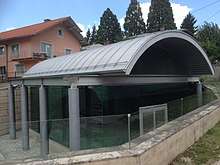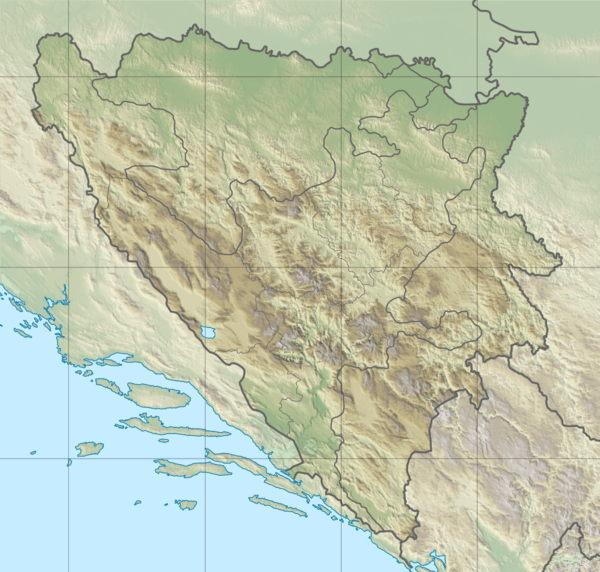Jajce Mithraeum
| Jajački mitrej | |
 The Mithraeum in Jajce on 16 July 2017 | |
 Location of Jajce in Bosnia and Herzegovina, where the temple is found | |
| Alternative name | Jajački Mithraeum |
|---|---|
| Location | Mitrasova, Jajce 70101, 87R8+8C Jajce |
| Region | Central Bosnia Canton |
| Coordinates | 44°20′27″N 17°15′58″E / 44.3407623°N 17.2660339°ECoordinates: 44°20′27″N 17°15′58″E / 44.3407623°N 17.2660339°E |
| Type | Temple, sanctuary |
| Length | around 7 metres (23 ft) |
| Width | less than 7 metres (23 ft) |
| Height | floor level is 2.80 metres (9.2 ft) below ground level |
| History | |
| Founded | early 4th century AD |
| Abandoned | Not known |
| Periods | Roman Imperial |
| Site notes | |
| Excavation dates | 1931 |
| Archaeologists | Dimitrije Sergejevski |
| Ownership | Public |
| Public access | Yes, limited |
| Website | Agency for Cultural, Historical and Natural Heritage and Development of Tourist Potential of Town Jajce |
The Jajce Mithraeum, or Jajački Mithraeum (Serbo-Croatian: Jajački mitrej), is a mithraeum, a temple dedicated to God of the Sun, Mithra, discovered in Jajce, Bosnia and Herzegovina.[1][2]
History
The god was worshiped and cult of Mithraism spread to other parts of Roman Empire, throughout the Mediterranean basin, by slaves and merchants from the Orient, and by Roman soldiers who came into contact with the followers of the cult in the East.[3]
Temple is dated to at least early 4th century AD. But there are signs that temple could be from 2nd century AD and then repaired sometime during early 4th century AD. This particular Mithraeum is renowned as one of the best preserved in-situ in Europe. It was discovered accidentally during the construction of private house.[1]
The Jajce site is typical spelaea. The Mithraism followers sought as a norm to found their places of worship in caves, whereas in absence of such topographical features they would excavate the soil, where the terrain permitted, and built small single-celled temple, known as spelaea, to reinforce the impression of a cave.
Discovery and protection
The remains of the Mithraeum in Jajce were discovered during excavation for the construction of a private building in 1931. The site was then purchased by the Society for the Preservation of Antiquities in Jajce. Wooden fence was erected for the time being, and soon afterwards a protective stone and mortar structure was designed and constructed under the supervision of engineer F. Steiner, to provide appropriate protection. [1] This structure was repaired in 1952, so it survived until 2012, despite significant damage suffered during 1992-96 war. New facility replaced this old one in 2012 project of renovation, which costed around 260.000 KM (BAM) and was carried out under the MDG-F program "Promotion cultural understanding in Bosnia and Herzegovina", with a financial support of Kingdom of Spain government. On this occasion temple is protected by modern glass walls so that visitors can see inside even without entering facility. However, for entrance and closer look visitors need to give notice of their visitation in advance by contacting the Ethnological museum of Jajce.
The Jajce Mithraeum is declared National Monument of Bosnia and Herzegovina.[1]
See also
References
- 1 2 3 4 "The historic (antique religious) monument of the Mithraeum in Jajce". old.kons.gov.ba (in English and Bosnian). Commision to preserve national monuments. 12 January 2003. Retrieved 22 September 2018.
- ↑ Bojanovski, Ivo (1988). Bosna i Hercegovina u antičko doba (in Bosnian and English). Akademija nauka i umjetnosti Bosne i Hercegovine. ISBN 9788671230193. Retrieved 22 September 2018.
- ↑ Basler, Đuro (1972). Arhitektura: kasnoantickog doba u Bosni i Hercegovini (in Bosnian and Croatian). Veselin Masleša. p. 65. Retrieved 22 September 2018.